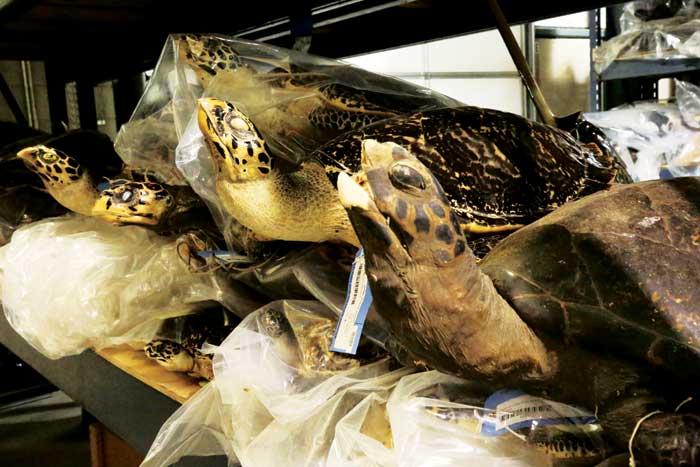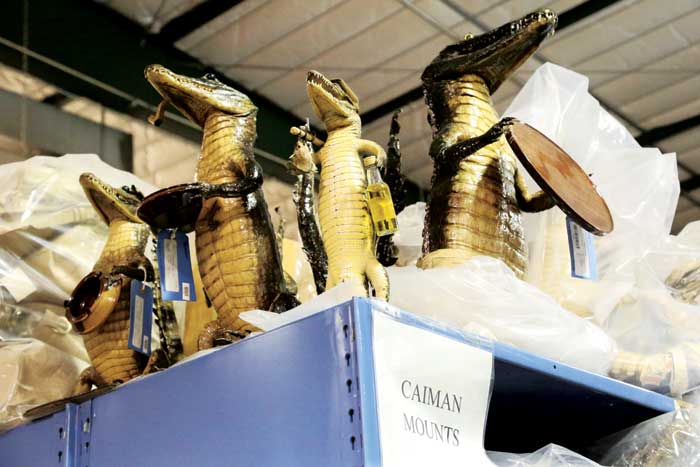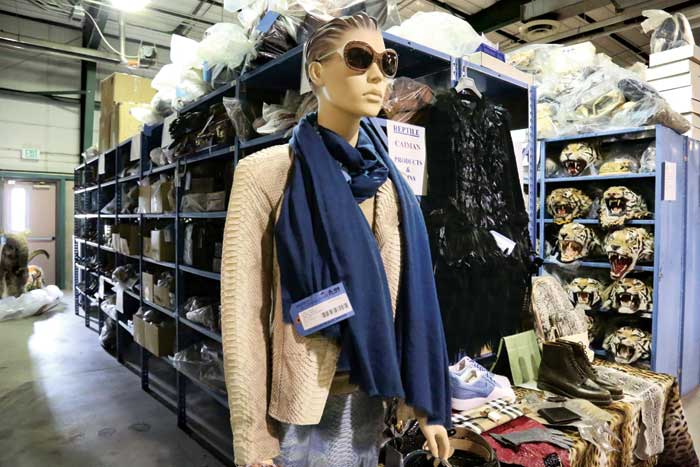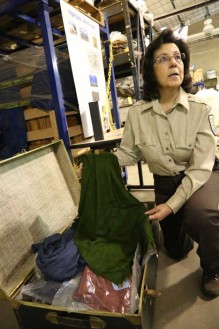Eyes that glowed in the night, searching for prey, now look glassy and emotionless. Wings that had majestic strength and span now look ghostly covered in plastic bags. Mouths that sounded infinitely strong roars now have an unnerving silence.
These were once some of the most beautiful animals, but were killed and made into products for the illegal wildlife trade. These products include purses, footstools, wall displays, medicines and much more.
“Isn’t it scary?” Bernadette Atencio said, pointing toward a stuffed tiger fetus, one of the particularly haunting items.
Atencio is the supervisor at the National Eagle and Wildlife Property Repository in the Rocky Mountain Arsenal—the only site in the U.S. that stores confiscated wildlife property. The repository is a vivid reminder of wildlife’s enemy: humans.
“The wildlife trade industry is a multibillion-dollar industry, and it involves species from all over the world,” Atencio said, waving a hand toward the rows dripping with exotic animals. At any one time, they house roughly 1.5 million animal parts and products confiscated by the Fish and Wildlife Service. “There is no species out there that cannot be vulnerable to this trade.”
Since its beginning, the Fish and Wildlife Service has been the guardian of the endangered. They monitor endangered and threatened animals, as well as those high in demand in the wildlife trade, like the python that’s often killed for clothing, shoes or accessories.
While some species reproduce fast enough to withstand being hunted for commercial uses, others cannot survive. The African elephant ivory market is so out of control the elephant population is disappearing.

Before sea turtles were illegal to import, their shells were commonly used for display or in antique furniture.

High on the endangered species list, the caiman is often made into purses or displays like these from Nicaragua. Pointing to a caiman holding a shooter and smoking a pipe, Bernadette Atencio calls these displays a huge disrespect to the animal.

The fashion industry fuels the demand for the exotic. At back, the $13,000 Alexander McQueen dress is made of mink, fox, bird feathers and caiman skin.
Special agents investigate overtly and covertly, and wildlife inspectors check for illegal items at U.S. ports of entry.
The 1973 Endangered Species Act prohibits importing and selling any endangered species in the U.S. A majority of the property at the repository is confiscated because of illegal import.
“Our law enforcement officers are seizing property daily. It is sent to us, and we are responsible for housing and disposing it,” Atencio said. A majority of the property is donated for public education purposes at museums, zoological parks and universities.
Despite the efforts by the Fish and Wildlife Service, Atencio anticipates they currently only seize 10 percent of all the illegal wildlife property coming into the U.S. It’s nearly impossible to inspect every shipment, said Atencio, who previously inspected wildlife property at Denver International Airport.

Atencio holds a scarf made of a rare Tibetan antelope. Producing the softest wool in the world, the antelope has fallen victim to fashion. Five antelopes die to make one scarf, which sells for $7,000 to $10,000. The antelope population has been decimated by poaching.
Besides investigating and confiscating property, the hardest part to defeat in the trade is the ongoing demand, according to Atencio. “People are very willing to pay for something that is rare,” she said. The fashion industry is a big culprit, using snakeskin and fur in expensive clothing. The repository stores wool scarves made of a rare Tibetan antelope that sell for $7,000 to $10,000. Five antelope are killed to make one scarf.
“There are species’ populations that are being devastated because people are creating a demand for the items that are made out of them,” she said. Many people are unaware of the size of the industry and how species are being affected, she noted.
In an effort to make people more aware, the Fish and Wildlife Service recently had a public event at the repository, crushing six tons of ivory worth millions of dollars.
“The intent was to make a very loud, very huge statement to the public that we won’t condone this industry.”
Unfortunately, in Atencio’s more than 30 years with the U.S. Fish and Wildlife Service, the black market hasn’t slowed. Despite laws, poaching and smuggling continue to flourish. She doesn’t anticipate an end to the wildlife trade, but hopes the collection at the repository will diminish. Until then, it remains a haunting image of humans’ effect on wildlife.
The repository is not open to the public, but tours of 10 or more people can be scheduled through Bernadette Atencio at bernadette_atencio@fws.gov. For more information about wildlife laws, visit www.fws.gov.



0 Comments